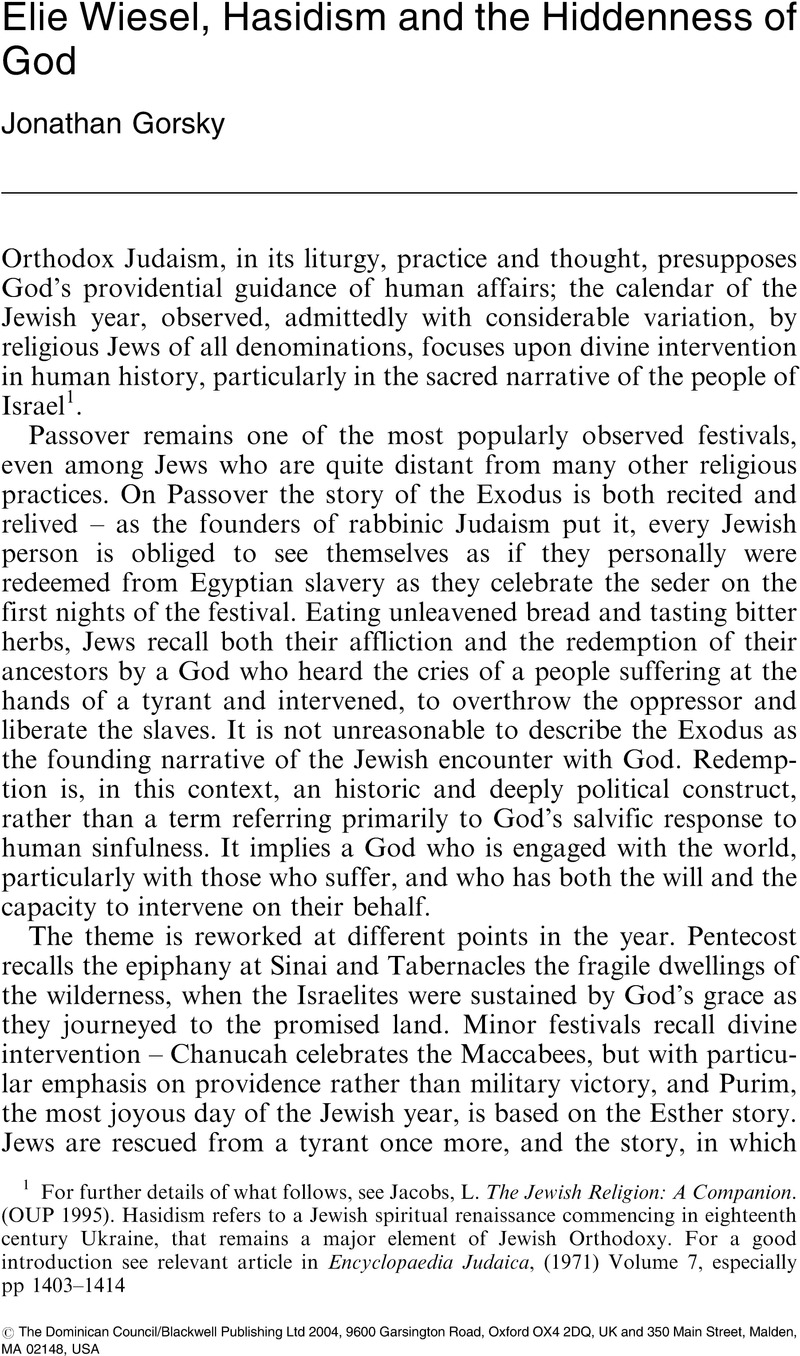No CrossRef data available.
Article contents
Elie Wiesel, Hasidism and the Hiddenness of God
Published online by Cambridge University Press: 01 January 2024
Abstract

- Type
- Catholic Theological Association 2003 Conference Papers
- Information
- Copyright
- Copyright © The Dominican Council/Blackwell Publishing Ltd 2004
References
1 For further details of what follows, see Jacobs, L. The Jewish Religion: A Companion. (OUP 1995Google Scholar). Hasidism refers to a Jewish spiritual renaissance commencing in eighteenth century Ukraine, that remains a major element of Jewish Orthodoxy. For a good introduction see relevant article in Encyclopaedia Judaica, (1971) Volume 7, especially pp 1403–1414
2 Wiesel, E. From the Kingdom of Memory, (Summit Books 1990) pp 136–145Google Scholar.
3 The extracts are reprinted in Schiff, H. (ed)Holocaust Poetry. (Fount 1995) pp 194–204Google Scholar. From Wiesel, E., Ani Maamin: A Song Lost and Found Again (Random House, 1973)Google Scholar. Used by permission of Random House, Inc. © Elie Wiesel.
4 Wiesel, E. Messengers of God: Biblical Portraits and Legends, (Summit 1976)Google Scholar especially pp 230–35.
5 For a summary and defence of Buber's view, see M., Friedman, Encounter on the Narrow Ridge: A Life of Martin Buber, (Paragon House, N.Y. 1993) PP 377–408Google Scholar. For Scholem's position see Scholem, G. The Messianic Idea in Judaism and other Essays on Jewish Spirituality, (Schocke, N.Y. 1971) pp 227–250Google Scholar.
6 For Rabbi Isaac Luria, see Gershom Scholem's article in Encyclopedia Judaica, pp 571–578.
7 For Lubavitch, see Elior, R. The Paradoxical Ascent to God. The Kabbalistic Theosophy of Habad Hasidism, (SUNY 1993)CrossRefGoogle Scholar For a useful but controversial introduction to R. Nahman of Breslov see Green, , A Tormented Master: The Life and Spiritual Quest of Rabbi Nahman of Bratslav, (Jewish Lights, Woodstock. Vermont 1992)Google Scholar, especially the excurses entitled Faith, Doubt and Reason, pp: 285–356 which I have drawn upon in this paper. For discussion on the impact of Rabbi Luria on Hasidic theology see Idel, M Hasidism: Between Ecstasy and Magic, (SUNY 1995) pp 31–45CrossRefGoogle Scholar. For an early and much discussed attempt to clearly distinguish different Hasidic theologies, see Weiss, J Studies in Eastern European Jewish Mysticism, (OUP, 1985) pp 43–55Google Scholar.
8 For the Breslov sources see Green A, ibid, pp. 285–336. The parable of the heart and the spring is quoted on p. 301.
9 For Rabbi Shapira see Polen, N The Holy Fire: The Teachings of Rabbi Kalonymus Kalman Shapira(Jason Aronson 1994)Google Scholar from which the sources quoted are taken. For Elie Wiesel's view of arguing with God see Wiesel, E. Souls on Fire(Summit 1972) p 111Google Scholar.




